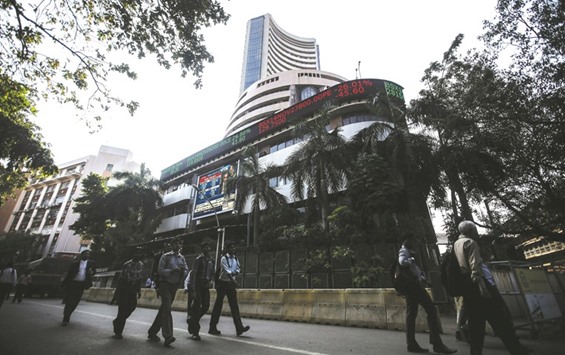Indian stocks dropped for the first time in three days, reversing earlier gains, on fears the central bank’s decision to keep interest rates unchanged will crimp economic growth.
The 30-share BSE index declined 155.89 points, or 0.59% to 26,236.87 yesterday.
Axis Bank, State Bank of India and ICICI Bank reversed gains to drop more than 1%. Analysts had overwhelmingly predicted a policy easing after the government’s November 8 decision to drain 86% of currency in circulation
dented economic activity. The worst-performer on the benchmark S&P BSE Sensex, however, was Sun Pharmaceutical Industries after the US Food & Drug Administration said an inspection of its Halol facility has given rise to a 14-page report that could list potential violations of the agency’s manufacturing guidelines.
“The over-protective, hawkish approach of the RBI will have adverse effects on the economy after demonetisation,” said Deven Choksey, managing director at KR Choksey Shares & Securities in Mumbai. “The need of the hour is for all government machinery to align itself to action the core objective of bringing growth back in the economy.”
The benchmark repurchase rate will stay at a six-year low of 6.25%, the Reserve Bank of India said in a statement in Mumbai yesterday. The move was predicted by only eight of 44 economists in a Bloomberg survey, while 31 expected a cut to 6% and five saw a reduction to 5.75%.
The decision risks souring ties with Prime Minister Narendra Modi’s government, which said its cash ban would create room for lower borrowing costs. Gross domestic product, which grew a slower-than-estimated 7.3% in July to September, is expected to slump to 6.5% this quarter, according to the median estimate in a Bloomberg survey.
The Sensex trades at 15.4 times 12-month projected earnings, compared with the MSCI Emerging Markets Index’s multiple of 12.1.
Meanwhile the rupee yesterday strengthened for the seventh consecutive sessions to closed at nearly one month high against the US dollar while 10 year bond yield jumped 20 basis points its biggest gains in over three years after the Reserve Bank of India kept interest rates unchanged.
The RBI cited inflation risks and high volatility in financial markets for keeping rates unchanged.
The decision to leave the repo rate unchanged — which had the unanimous consent of all six members of the monetary policy committee — comes as a surprise. Eleven of 14 economists and bankers surveyed by Mint expected the monetary policy committee to reduce the benchmark rate by 25 bps at the monetary policy review. One expected a sharper 50 bps rate cut.
“The reaction in the bond markets was due to the unchanged policy rates by the RBI as market was expecting rate cut”, said Soumyajit Niyogi, associate director, India Ratings.
The rupee closed at 67.64 a dollar — a level last seen on November 11, from its previous close of 67.90. The rupee opened at 67.82 and touched a high of 67.63 a dollar. So far this year it fell 2.2%.
The bond yield closed at 6.408% — a level last seen on November 18, up 21 basis points, the maximum gains since September 23, 2013 from its previous close of 6.203%.
“Governor has taken the call to hold the temptation ahead of the Federal Reserve meeting. By not increasing the rate RBI Governor is looking more extrovert and is concerned about the international volatility”, said Motilal Oswal chairman and managing director of Motilal Oswal Securities. “This is a good tactical call as this will still leave a chance with RBI governor to see how the global economy reacts to fed move and then take a call on domestic Interest rates”, he added.
The central bank has also cut its gross value added (GVA) growth estimate for fiscal 2016-17 by 50 basis points to 7.1% as it believes that the recent demonetisation of certain currency notes is likely to have a near term negative impact on economic activity. One basis point is one-hundredth of a percentage point.
Oswal expects that If the rate hike in US happens then that will increase the probability of flows moving away from EM and into US treasury. With the reduction of domestic interest rates there would be additional outflow from Domestic debt as the gap between risk adjusted return in domestic debt vs US treasury reduces substantially.

People walk by the Bombay Stock Exchange building in Mumbai. The 30-share BSE Sensex closed down 155.89 points to 26,236.87 yesterday.
